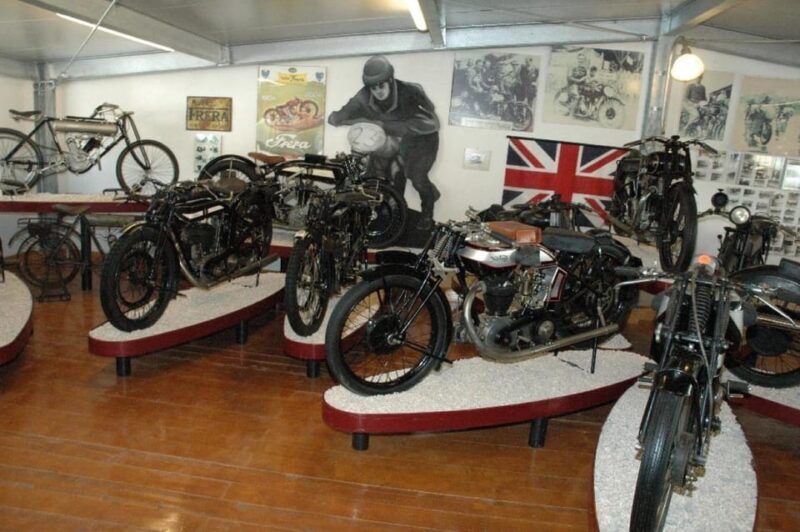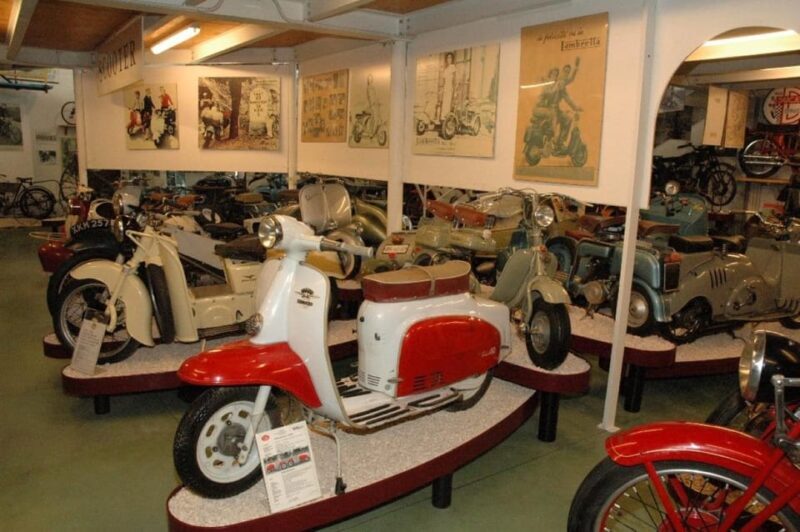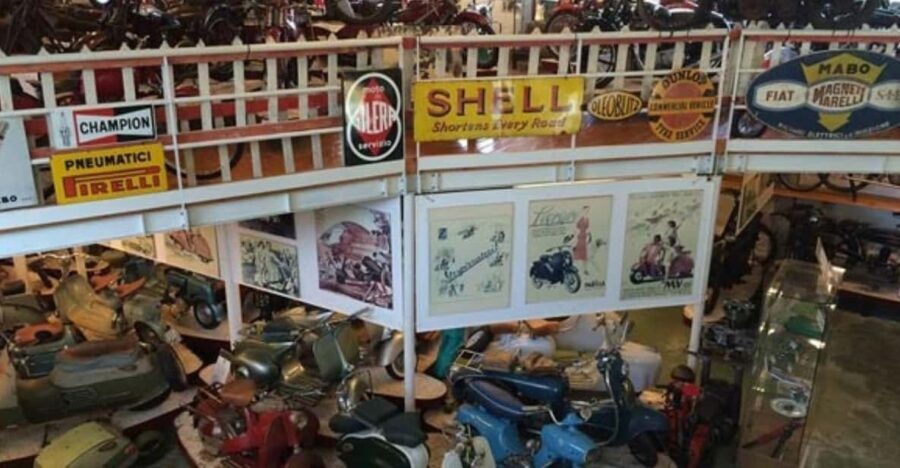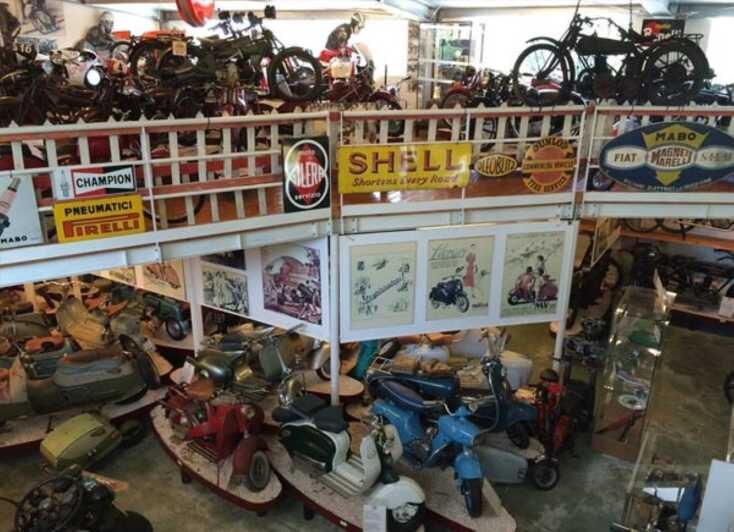Looking for a unique slice of Italian history that combines nostalgia, craftsmanship, and a touch of adrenaline? The National Motorcycle Museum in Rimini offers just that. For only $8 per person, visitors can step into a well-curated world of over 250 vintage motorcycles from 55 different brands—a true treasure trove for bike lovers and history buffs alike. The museum is open daily from 9:30 am to 12:30 pm and 2:30 pm to 6:30 pm, making it easy to fit into your sightseeing plans.
What we particularly love about this experience are two things: first, the organically arranged exhibits that tell a comprehensive story from the earliest motorbikes to modern classics, and second, the passionate display that clearly shows how much care and knowledge the curators have poured into the collection. It’s a chance to see rare pieces like the Frera SS 4V of 1924 and the Moto Guzzi 500 GTV of 1937, some of which aren’t available anywhere else. A minor consideration? The museum’s size and focus mean it’s best suited for those genuinely interested in motorcycles or vintage vehicles, as casual visitors might find it less engaging if they’re not already enthusiasts.
This museum is perfect for motorcycle fans — especially those interested in historical models, Italian brands, or vintage engineering. It’s also a wonderful stop if you’re seeking an authentic, affordable experience that’s a little off the beaten tourist path.
Key Points

- Affordable Entry: Only $8 for a deep look at vintage motorcycles.
- Rich Collection: Over 250 bikes representing 55 brands, with rare and historic models.
- Themed Sections: The exhibits are divided into specific themes, offering clear storytelling.
- Passionate Curation: The display shows evident enthusiasm and knowledge from the curators.
- Ideal for Enthusiasts: Best suited for those with a genuine interest in motorcycles or Italian vehicle history.
- Accessible & Convenient: Open daily with flexible hours and wheelchair accessibility.
Detailed Review of the Motorcycle Museum Experience

Museum lover? We've covered these other cultural institutions in Rimini
Location and Setting
The National Motorcycle Museum is located in Rimini, Italy, within the region of Emilia-Romagna, a place famous for Italian craftsmanship and automotive excellence. Since opening in 1993, it’s proudly Italy’s first dedicated motorcycle museum, and it continues to attract visitors who want to see a detailed history of two-wheeled vehicles. The museum’s location makes it an easy addition to a day of exploring Rimini’s beaches or historic sites.
How to Get There and What to Expect
The museum is accessible and open every day, with consistent hours from 9:30 am to 12:30 pm and 2:30 pm to 6:30 pm. There’s no mention of guided tours or transportation included, so most visitors simply purchase an entry ticket and explore at their own pace. The entry fee is quite affordable at $8, making it a good value for anyone wanting a focused, in-depth look at vintage motorcycles.
The Collection: A History in Motion
Once inside, you’ll find yourself immersed in a carefully organized display that takes you through the evolution of motorcycles. The collection showcases early models from the late 1800s and early 1900s, giving a glimpse into the pioneering days of motorized transport, with bikes that look almost as if they could start up at any moment.
Moving through the exhibits, you’ll find notable bikes like the Frera SS 4V of 1924, a rare piece that highlights Italian innovation from nearly a century ago. The twin-cylinder Frera with opposed valves and 1140 cc is a real highlight for enthusiasts. The collection also features significant models of legendary brands such as Moto Guzzi, Ducati, Harley Davidson, Benelli, Norton, and many more.
More Great Tours NearbyThemed Sections
The museum’s design divides the bikes into various themes, which makes for a logical and engaging flow. For example:
– Pioneers of motorcycling: Bikes from the earliest days, showing the rough-and-tumble origins of the sport.
– Between the wars: Classic models from the interwar period that demonstrate technological advances.
– Sidecars and scooters: A section dedicated to utilitarian and recreational vehicles.
– Grand Prix motorcycles: The high-speed racing bikes of international fame, showing the sport’s competitive side.
– Post-war utilitarian bikes and local Rimini designs: Offering insight into the broader social and industrial history of Italy.
One reviewer described the exhibition as “designed with much passion,” emphasizing the care put into the display and storytelling.
Highlights and Must-Sees
Among the most striking pieces is the Moto Guzzi 500 GTV, once owned by artist Antonio Ligabue, adding a dash of cultural history to the technical marvels. The rare and unique models like the Bimota prototypes and vintage sidecars add to the museum’s appeal.
What We Loved
We appreciated how the exhibits are organically arranged, making the progression through motorcycle history both educational and visually appealing. The passion of the curators shines through, making even technical details accessible and engaging. The quality and rarity of some bikes were a thrill to see up close, offering a tangible link to Italy’s engineering prowess.
What Could Be Better
While the collection is extensive, the museum’s relatively small size might feel limiting to some visitors, especially those seeking a large-scale or interactive experience. Also, since there are no guided tours included, visitors looking for detailed narratives might wish for some available audio guides or plaques with more stories.
Who Will Enjoy This
This museum is best suited for motorcycle enthusiasts, history buffs, and Italian culture fans. If you have even a casual interest in vintage bikes or Italian brands, you’ll find plenty to admire. It’s less ideal for small children or casual travelers looking for a quick, general sightseeing stop.
Final Thoughts on the Value

For only $8, the National Motorcycle Museum offers a well-curated window into the past of two-wheeled vehicles. Its focus on rare models, Italian craftsmanship, and dedicated exhibits makes it a worthwhile stop for those with a curiosity about engineering or a love of vintage design. The passionate curation and organized themes help create an immersive experience, even if the size is modest.
If you’re staying in Rimini and have an hour or two to spare, this museum provides a charming and affordable look at a niche but fascinating slice of Italy’s industrial and cultural history. It’s a quiet, satisfying experience that rewards visitors willing to appreciate the details and stories behind each bike.
FAQ

Is the museum open every day?
Yes, it is open daily from 9:30 am to 12:30 pm and 2:30 pm to 6:30 pm.
How much does an entry ticket cost?
The entry fee is $8 per person, making it a budget-friendly option.
Are there guided tours available?
The information doesn’t specify guided tours, so visitors explore independently with their ticket.
Is the museum wheelchair accessible?
Yes, the museum is wheelchair accessible.
Can I cancel my reservation?
Yes, you can cancel up to 24 hours in advance for a full refund.
How long should I plan to spend here?
Most visitors probably spend about 1 to 2 hours exploring the exhibits at a leisurely pace.
What kind of motorcycles are on display?
The museum features vintage bikes from the late 1800s to modern classics, including rare pieces and models from major Italian brands like Ducati and Moto Guzzi.
Is the museum suitable for children?
While suitable for all ages, the focus on vintage motorcycles and technical details might appeal more to older children or adults.
Are there any special exhibits or events?
The available information doesn’t mention special exhibits; the collection is the main attraction.
What is the best way to get there?
Most visitors will find it easiest to reach by car or local transport, but check your local maps for precise directions.
Whether you’re a motorcycle enthusiast or someone curious about Italy’s engineering legacy, the Rimini National Motorcycle Museum offers a sincere, affordable, and well-organized journey through the history of two wheels. It’s a quiet gem that rewards those willing to look closely and appreciate the craftsmanship of vintage motorbikes.
You can check availability for your dates here:More Museum Experiences in Rimini
More Tour Reviews in Rimini
- San Marino: UNESCO World Heritage Site Private Tour
- Rimini Scavenger Hunt and Highlights Self-Guided Tour
- Rimini: digital guide made with a local for a walking tour
- Rimini Walking Tour with Audio and Written Guide by a Local
- Private Guided Walking Tour in Santarcangelo Slow City
- Dining experience and Show Cooking at a Local’s home in Rimini
More Rimini experiences we've covered
- San Marino: UNESCO World Heritage Site Private Tour
- Rimini’s 3 Best Dinner Experiences (With Prices & Reviews)
- 3 Most Highly Rated Dining Experiences In Rimini
- 3 Best Workshops & Classes In Rimini
- 6 Best Walking Tours In Rimini (With Reviews & Prices)
- Top 15 Tours In Rimini
- We Rank Rimini’s 5 Top Cooking Classes
- Rimini’s 7 Best City Tours: Which To Choose?
- Rimini Scavenger Hunt and Highlights Self-Guided Tour
- Rimini: digital guide made with a local for a walking tour
- Rimini Walking Tour with Audio and Written Guide by a Local
- Private Guided Walking Tour in Santarcangelo Slow City
